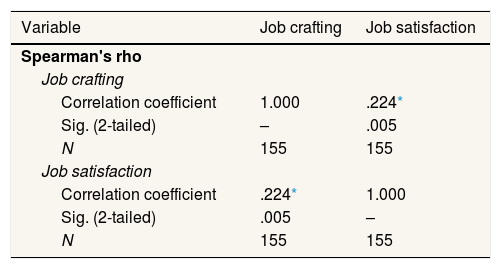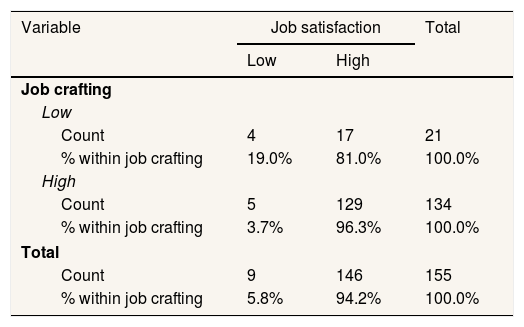
The 1st International Conference on Safety and Public Health
Más datosThis study aimed to see the correlation between JC and JS of hospital staff in Rural area, Mamuju at 4.0 era.
MethodThe population was all staff of three hospitals, 614 respectively at Mamuju regency, West Sulawesi Province and 155 staff selected as samples. The sample was chosen by random quota sampling, then analyzed using the Spearman correlation test.
ResultsThe results showed that most of the staff were satisfied with their job (90% average) while more than 80% of staff perceived the did JC. The result of the correlation test revealed that the p value of 0.005<0.05 means hypothesis null was rejected. There was correlation between JC and JS. The correlation coefficient was 0.224 showing a positive direction of the relationship even though it was a weak correlation.
ConclusionsJC can cause JS when the staff have other supporting factors. JC may enhance JS significantly when supported by other factors, such as job security, good compensation work itself and relationship with immediate supervisor.
In a decade, hospital industrial growth significantly due to the widespread development of technology and globalization. Currently, the industrial revolution 4.0 era rises to a challenge for hospital management. The era of disruption has a significant effect on hospital management.1 The demand for quality health services tends to be unpredictable, uncertain, complex and ambiguous. Hospital managers should enhance quality of service beyond customer expectation and create innovative organizations. Hence, the manager should encourage hospital staff to innovate in response to this situation. Some studies found that a disruptive era should be followed by increasing dynamic capability of organization, including human resources.2,3 Innovation organization can be created by having innovative employee.4 The innovative employee can result from highly satisfied employees and it is related to job crafting behaviour (JC).2 Furthermore, job crafting is staff behaviour towards his job, trying to fit their job with their passion. Staff may will modify the working method to achieve the goals.5–8
Job crafting is influenced by the level of job demand and job resources.3 In the Job-demand-resources (JD-R) model, with the standard characteristics of optimal job demands and providing the resources necessary work of employees, as a whole can satisfy employees in completing their work.4
Job satisfaction is defined as positive or negative evaluative judgments about the work and the situation.5 If employee engagement and job satisfaction are not optimal, it may cause a variety of adverse outcomes for organizations such as reduced commitment, lower productivity, and increased employee turnover.6,7
In the hospital context, most staff have to follow standard operating procedures (SOP) when they do their tasks. It is concerned with patient safety. However, the hospital has to encourage job crafting behaviour among staff because it is the most important skill to deal with the uncertainty era due to the high demand for quality health services. Conversely, to be innovative, the staff have to be satisfied. Ali found that innovative behaviour was influenced by satisfaction in personal life. Another study found that neuroticism people may find difficulties in innovating. It means that satisfaction plays an important role to be innovative. Job crafting behaviour is related to Innovation behaviour. Some studies regarding the relationship of job crafting and job satisfaction have been done.9 Jui-Chang Cheng studied on hotel's employees stated that there was a relationship of job crafting and job satisfaction. Another study found that JC has an impact on job engagement and service recovery of flight attendants (karatepe).10 Ogbuanya also revealed the relationship has been proved at education institutions. It is still limited study about the relationship of job crafting and job satisfaction in health care context.11
MethodQuantitative research and cross-sectional approach were used in this study. The population of this study is all hospital staff at 3 hospitals as many as 614 staff in Mamuju regency, West Sulawesi, which is Mamuju regional hospital, Bhayangkara Hospital of Polda Sulbar, and Mitra Manakarra Mamuju Hospital. The sampling technique was random quota sampling, totaling 155 hospital staff who were selected as samples with inclusion and exclusion criteria. The inclusion criteria were: hospital staff who are currently active in health services. The exclusion criteria were: hospital staff who were sick, on leave, were in training, and were taking study assignments during the study. The instrument used in this study was a valid and reliable structured questionnaire.
Job crafting instrument utilizes 21 items of Job Crafting Questionnaire to be expanded by Tims and Bakker.8 It consists of the dimensions of structural work resources (5 items), inhibiting job demands (5 items), social work resources (5 items), and challenging job demands (5 items). Job crafting measured using 4-point Likert scale from 1 (never) to 4 (always). Job satisfaction instrument using 15 items from the Job Satisfaction Scale be expanded by Warr, Cook and Wall.9 Consists of intrinsic job satisfaction dimensions (8 items) and extrinsic job satisfaction (7 items). Job satisfaction measured using 6-point Likert scale from 1 (very dissatisfied) to 6 (very satisfied).
ResultsAnalysis characteristics of hospital staffCharacteristics of hospital staff in this study were analyzed using the Descriptive Statistics Frequencies Test with the results of the majority being female (81.9%). Respondents in the age group ≤30 years of providing the largest percentage by 99 persons (63.9%). The positions of respondents were mostly staff of 148 people (95.5%). Respondents with D3 provide the largest percentage of 65 (41.9%). Respondents with nurses provide the largest percentage of 99 people (63.9%). In terms of length of work, many respondents have worked >2 years, 89 people (57.4%) with the most employment status is private contract 49 people (31.6%).
Correlation analysis job crafting with job satisfactionThe results of the analysis used were the Spearman test to determine the relationship between job crafting and job satisfaction. Based on the research output in Table 1, shows the Sig. p-value of 0.005<α 0:05, meaning that there is a significant relationship between job crafting with job satisfaction. The correlation value of 0.224 is defined as a positive correlation with the strength of the relationship is very weak (0:00 to 0:25). Thus, it can be concluded that there was a significant relationship between job crafting and job satisfaction on the hospital staff, with the strength of the relationship being very weak but the direction of the relationship is unidirectional (positive).
Correlation analysis between job crafting with job satisfaction on the hospital staff in Mamuju regency 2020.
Output Table 2 using the analysis results from cross-tabulation among job crafting with job satisfaction. The result shows the majority of hospital staff have a good job crafting as many as 129 (96.3%), and they feel good job satisfaction.
Cross-tabulation analysis between job crafting with job satisfaction on the hospital staff in Mamuju regency 2020.
| Variable | Job satisfaction | Total | |
|---|---|---|---|
| Low | High | ||
| Job crafting | |||
| Low | |||
| Count | 4 | 17 | 21 |
| % within job crafting | 19.0% | 81.0% | 100.0% |
| High | |||
| Count | 5 | 129 | 134 |
| % within job crafting | 3.7% | 96.3% | 100.0% |
| Total | |||
| Count | 9 | 146 | 155 |
| % within job crafting | 5.8% | 94.2% | 100.0% |
Based on Table 3, it is recognized that the output coefficient of the Sig. p-value obtained for the extrinsic factors are 0.000 and the intrinsic factors are 0.000. Both independent variables had a p-value <0.05. It is concluded that the extrinsic and intrinsic factors variable effect on job satisfaction.
Linear regression analysis of job satisfaction variable (extrinsic factors and intrinsic factors) hospital staff in Mamuju regency 2020.
| Model | Unstandardized coefficients | Standardized coefficients | T | Sig. | |
|---|---|---|---|---|---|
| B | Std. error | Beta | |||
| (Constant) | 0.608 | 0.077 | 7.845 | .000 | |
| Extrinsic factors | 0.280 | 0.036 | 0.401 | 7.687 | .000 |
| Intrinsic factors | 0.427 | 0.040 | 0.556 | 10.647 | .000 |
Dependent variable: job satisfaction.
The result of correlation analysis between job crafting and job satisfaction shows that the p-value is 0.005<0.05, which means that there is a relationship between job crafting and job satisfaction. The correlation coefficient value of 0.224 is defined as a positive correlation with the strength of the correlation is very weak. The positive correlation is the relationship between two variables, which increases the variable values on other variables. Otherwise, the smaller the value of a variable, the decrease of other variables’ value. So that job crafting with the job satisfaction variable has a relationship and a positive unidirectional, meaning that the higher the level of job crafting for hospital staff, there will be an increase in the job satisfaction of hospital staff. The cross-tabulation analysis shows that hospital staff who have good job crafting will have good job satisfaction. This result is supported by Wrzesniewski and Dutton,10 which states that through job crafting, employees will be motivated to meet the needs of a positive self-evaluation and will be satisfied with their jobs. The value of motivation for hospital staff is to optimize the quality of health services to patients. To motivate hospital workers, management should identify the dimensions of the work activities of their employees in job crafting, besides training and feedback from the immediate supervisor.
In the linear regression analysis (coefficient) of the job satisfaction variable, it is known that job crafting is influenced by extrinsic and intrinsic factors. There is a relationship between job crafting and job satisfaction, due to extrinsic and intrinsic factors. Extrinsic factors are environmental working conditions, co-workers relations, immediate supervisor, the level of payments, industrial relations between management and workers at the hospital the way the organization is managed, working hours, job safety, and hospital staff.1,2 The intrinsic factors are the freedom to choose the method of work, obtained recognition for a good job, the responsibility received, the opportunity to use capabilities, promotion opportunities, attention to the suggestions made, and the variations in the work of the hospital staff.12–14 Besides, job crafting can boost job satisfaction when hospital staff has other supporting factors. Job crafting can increase job satisfaction significantly if supported by other factors such as job security, good compensation, the work itself, and the relationship with their immediate supervisor.5,15,16
Research conducted by Tim, Bakker dan Derks17 by using Structural Equation Modelling (SEM) indicates that employees who make the resources of their jobs in the first-month study showed an increase in structural and social resources during the study period (2 months). Increased resources, positively related to employee benefits (increase engagement and job satisfaction, and reduce fatigue.
ConclusionsJob crafting can affect job satisfaction if hospital staff have other supporting factors. Job crafting can increase job satisfaction significantly if it is supported by other factors such as job security, good compensation, the work itself, and the relationship with their immediate supervisor. For further research, the study about the influence of job crafting and all the factors of job satisfaction is required and expected to use multivariate analysis, then looking at the highest contributing factor to the job satisfaction of nurses.
Conflicts of interestsThe authors declare that they have no conflict of interest.
Peer-review under responsibility of the scientific committee of the 1st International Conference on Safety and Public Health (ICOS-PH 2020). Full-text and the content of it is under responsibility of authors of the article.
















